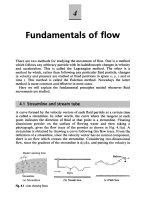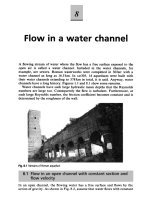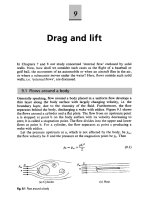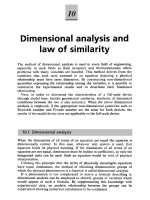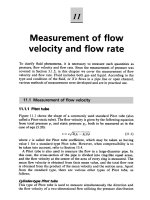Introduction to fluid mechanics - P4
Bạn đang xem bản rút gọn của tài liệu. Xem và tải ngay bản đầy đủ của tài liệu tại đây (863.21 KB, 14 trang )
Fundamentals of flow
There are two methods for studying the movement of flow. One is a method
which follows any arbitrary particle with its kaleidoscopic changes in velocity
and acceleration. This is called the Lagrangian method. The other is a
method by which, rather than following any particular fluid particle, changes
in velocity and pressure are studied at fixed positions in space x, y, z and at
time t . This method is called the Eulerian method. Nowadays the latter
method is more common and effective in most cases.
Here we will explain the fundamental principles needed whenever fluid
movements are studied.
A curve formed by the velocity vectors of each fluid particle at a certain time
is called a streamline. In other words, the curve where the tangent at each
point indicates the direction of fluid at that point is a streamline. Floating
aluminium powder on the surface of flowing water and then taking a
photograph, gives the flow trace of the powder as shown in Fig. 4.l(a). A
streamline is obtained by drawing a curve following this flow trace. From the
definition of a streamline, since the velocity vector has no normal component,
there is no flow which crosses the streamline. Considering two-dimensional
flow, since the gradient of the streamline is dyldx, and putting the velocity in
Fig. 4.1 tines showing flow
42 Fundamentalsof flow
Fig. 4.2 Relative streamlines and absolute streamlines
the x and y directions as u and v respectively, the following equation of the
streamline is obtained:
dx/u = dy/v
(4.1)
Whenever streamlines around a body are observed, they vary according
to the relative relationship between the observer and the body. By moving
both a cylinder and a camera placed in a water tank at the same time, it is
possible to observe relative streamlines as shown in Fig. 4.2(a). On the other
hand, by moving just the cylinder, absolute streamlines are observed (Fig.
4.2(b)).
In addition, the lines which show streams include the streak line and the
path line. By the streak line is meant the line formed by a series of fluid
particles which pass a certain point in the stream one after another. As shown
in Fig. 4.l(b), by instantaneously catching the lines by injecting dye into the
flow through the tip of a thin tube, the streak lines showing the turbulent flow
can be observed. On the other hand, by the path line is meant the path of
one particular particle starting from one particular point in the stream. As
shown in Fig. 4.l(c), by recording on movie or video film a balloon released
in the air, the path line can be observed.
In the case of steady flow, the above three kinds of lines all coincide.
By taking a given closed curve in a flow and drawing the streamlines
passing all points on the curve, a tube can be formulated (Fig. 4.3). This tube
is called a stream tube.
Since no fluid comes in or goes out through the stream tube wall, the fluid
is regarded as being similar to a fluid flowing in a solid tube. This assumption
is convenient for studying a fluid in steady motion.
Three, twe and onedimensional flow 43
Fig. 4.3 Stream tube
A flow whose flow state expressed by velocity, pressure, density, etc., at any
position, does not change with time, is called a steady flow. On the other
hand, a flow whose flow state does change with time is called an unsteady
flow. Whenever water runs out of a tap while the handle is being turned, the
flow is an unsteady flow. On the other hand, when water runs out while the
handle is stationary, leaving the opening constant, the flow is steady.
All general flows such as a ball flying in the air and a flow around a moving
automobile have velocity components in x , y and z directions. They are called
three-dimensional flows. Expressing the velocity components in the x , y and
z axial directions as u, u and w ,then
u = u(x, y , z , t )
u = u(x, y , z, t )
w = w ( x , y, z , t )
(4.2)
Consider water running between two parallel plates cross-cut vertically to
the plates and parallel to the flow. If the flow states are the same on all planes
parallel to the cut plane, the flow is called a two-dimensional flow since it
can be described by two coordinates x and y. Expressing the velocity
components in the x and y directions as u and u respectively, then
u = u(x, y, t )
u = u(x, y, t )
(4.3)
and they can be handled more simply than in the case of three-dimensional
flow.
As an even simpler case, considering water flowing in a tube in terms of
average velocity, then the flow has a velocity component in the x direction
only. A flow whose state is determined by one coordinate x only is called a
one-dimensional flow, and its velocity u depends on coordinates x and t
only:
44 Fundamentals of flow
u = u(x, t)
(4.4)
In this case analysis is even simpler.
Although all natural phenomena are three dimensional, they can be studied
as approximately two- or one-dimensional phenomena in many cases. Since
the three-dimensional case has more variables than the two-dimensional case,
it is not easy to solve the former. In this book three-dimensional formulae
are omitted.
On a calm day with no wind, smoke ascending from a chimney looks like a
single line as shown in Fig. 4.4(a). However, when the wind is strong, the
smoke is disturbed and swirls as shown in Fig. 4.4(b) or diffuses into the
peripheral air. One man who systematically studied such states of flow was
Osborne Reynolds.
Reynolds used the device shown in Fig. 4.5. Coloured liquid was led to
the entrance of a glass tube. As the valve was gradually opened by the handle,
the coloured liquid flowed, as shown in Fig. 4.6(a), like a piece of thread
without mixing with peripheral water.
When the flow velocity of water in the tube reached a certain value, he
observed, as shown in Fig. 4.6(b) that the line of coloured liquid suddenly
became turbulent on mingling with the peripheral water. He called the former
flow the laminar flow, the latter flow the turbulent flow, and the flow velocity
at the time when the laminar flow had turned to turbulent flow the critical
velocity.
A familiar example is shown in Fig. 4.7. Here, whenever water is allowed
to flow at a low velocity by opening the tap a little, the water flows out
smoothly with its surface in the laminar state. But as the tap is gradually
opened to let the water velocity increase, the flow becomes turbulent and
opaque with a rough surface.
Fig. 4.4 Smoke from a chimney
Laminar flow and turbulent flow 45
Fig. 4.5 Reynolds' experiment'
Fig. 4.6 Reynolds' sketch of transition from laminar flow to turbulent flow
'
Reynolds, O., Philosophical Transactions ofthe Royal Society, 174 (1883), 935.
46
Fundamentals of flow
Fig. 4.7 Water flowing from a faucet
Reynolds conducted many experiments using glass tubes of 7, 9, 15 and
27 mm diameter and water temperatures from 4 to 44°C. discovered that
He
a laminar flow turns to a turbulent flow when the value of the nondimensional quantity p v d / p reaches a certain amount whatever the values of
the average velocity v , glass tube diameter d, water density p and water
viscosity p. Later, to commemorate Reynolds’ achievement,
pvd vd
Re = -= - (v is the kinematic viscosity)
P
V
(4.5)
was called the Reynolds number. In particular, whenever the velocity is the
critical velocity v,, Re, = v,d/v is called the critical Reynolds number. The
value of Re, is much affected by the turbulence existing in the fluid coming
into the tube, but the Reynolds number at which the flow remains laminar,
however agitated the tank water, is called the lower critical Reynolds
number. This value is said to be 2320 by Schiller2. Whenever the experiment
is made with calm tank water, Re, turns out to have a large value, whose
upper limit is called the higher critical Reynolds number. Ekman obtained a
value of 5 x io4 for it .
In general, liquid is called an incompressible fluid, and gas a compressible
fluid. Nevertheless, even in the case of a liquid it becomes necessary to take
compressibility into account whenever the liquid is highly pressurised, such
*
Wien, W. und Harms, F., Handbuch der Experimental Physik, IV, 4 Teil, Akademische
Verlagsgesellschaft (1932), 127.
Rotation and spinning of a liquid 47
Osborne Reynolds (1842-1912)
Mathematician and physicist of Manchester,
England. His research covered all the fields of physics
and engineering - mechanics, thermodynamics,
electricity, navigation, rolling friction and steam
engine performance. He was the first to clarify the
phenomenon of cavitation and the accompanying
noise. He discovered the difference between laminar
and turbulent flows and the dimensionless number,
the Reynolds number, which characterises these
flows. His lasting contribution was the derivation of
the momentum equation of viscous fluid for
turbulent flow and the theory of oil-film lubrication.
as oil in a hydraulic machine. Similarly, even in the case of a gas, the
compressibility may be disregarded whenever the change in pressure is small.
As a criterion for this judgement, A p / p or the Mach number M (see Sections
10.4.1 and 13.3) is used, whose value, however, varies according to the nature
of the situation.
Fluid particles running through a narrow channel flow, while undergoing
deformation and rotation, are shown in Fig. 4.8.
Fig. 4.8 Deformation and rotation of fluid particles running through a narrowing channel
48 Fundamentals of flow
Fig. 4.9 Deformation of elementary rectangle of fluid
Now, assume that, as shown in Fig. 4.9, an elementary rectangle of fluid
ABCD with sides dx, dy, which is located at 0 at time t moves to 0’while
deforming itself to A’B‘C’D’time dt later.
AB in the x direction moves to A‘B’ while rotating by dq, and AD in the
y direction rotates by de,. Thus
av
de - - dxdt
1 - ax
at4
d 2 = -- dydt
E
aY
de - L = - d av
d~
t
I - dx
ax
de --=--dt
dE2
dy
au
’-
ay
The angular velocities of AB and AD are o1and o2respectively:
de,
--=1 - dt
( j
J
av
ax
de2
dt
at4
ay
a,=-=--
For centre 0, the average angular velocity o is
o=t(W1+W2)=-
--(”
2 ax
1
ay
av>
Putting the term in the large brackets of the above equation as
(4.6)
Rotation and spinning of a liquid 49
(a)
F o d vortex flow
(b) Free vortex flow
Fig. 4.10 Vortex flow
(4.7)3
gives what is called the vorticity for the z axis. The case where the vorticity
is zero, namely the case where the fluid movement obeys
is called irrotational flow.
As shown in Fig. 4.10(a), a cylindrical vessel containing liquid spins about
the vertical axis at a certain angular velocity. The liquid makes a rotary
’In general, vector
with the following components x, y, z for vector V (components x, y, z
are u, v, w) is called the rotation or curl of vector V, which can be written as rot V,curl V and
V x V (V is called nabla). Thus
Equation (4.7) is the case of two-dimensional flow where w = 0. V is an operator which
represents
a
a
a
ax
ay
az
i-+j-+k-
where i,j , k are unit vectors on the x, y. z axes.
50 Fundamentals of flow
Fig. 4.11 Tornado
movement along the flow line, and, at the same time, the element itself
rotates. This is shown in the upper diagram of Fig. 4.10(a), which shows how
wood chips float, a well-studied phenomenon. In this case, it is a rotational
flow, and it is called a forced vortex flow. Shown in Fig. 4.10(b) is the case of
rotating flow which is observed whenever liquid is made to flow through a
small hole in the bottom of a vessel. Although the liquid makes a rotary
movement, its microelements always face the same direction without
performing rotation. This case is a kind of irrotational flow called free vortex
flow.
Hurricanes, eddying water currents and tornadoes (see Fig. 4.11) are
familiar examples of natural vortices. Although the structure of these vortices
is complex, the basic structure has a forced vortex at its centre and a free
vortex on its periphery. Many natural vortices are generally of this type.
As shown in Fig. 4.12, assuming a given closed curve s, the integrated u:
(which is the velocity component in the tangential direction of the velocity us
at a given point on this curve) along this same curve is called the circulation
Circulation 51
Fig. 4.12 Circulation
r. Here, counterclockwise rotation is taken to be positive. With the angle
between us and v: as 8, then
r=
# f
v:ds=
(4.9)
V,COS~~S
Next, divide the area surrounded by the closed curve s into microareas by
lines parallel to the x and y axes, and study the circulation dT of one such
elementary rectangle ABCD (area dA), to obtain
dr=udx+
( 3( 3
v+-dx
dy-
u+-dy
dx-vdy= ( g - g ) d x d y
= [dxdy = CdA
(4.10)
C is two times the angular velocity
w of a rotational flow (eqn (4.6)), and
the circulation is equal to the product of vorticity by area. Integrate eqn
(4.10) for the total area, and the integration on each side cancels leaving only
the integration on the closed curve s as the result. In other words,
r=#u:ds=#ACdA
(4.1 1)
From eqn (4.1 1) it is found that the surface integral of vorticity 5 is equal to
the circulation. This relationship was introduced by Stokes, and is called
Stokes’ theorem. From this finding, whenever there is no vorticity inside a
closed curve, then the circulation around it is zero. This theorem is utilised in
fluid dynamics to study the flow inside the impeller of pumps and blowers
as well as the flow around an aircraft wing.
52 Fundamentals of flow
George Gabriel Stokes (1819-1903)
Mathematician and physicist. He was born in Sligo in
Ireland, received his education at Cambridge,
became the professor of mathematics and remained
in England for the rest of his life as a theoretical
physicist. More than 100 of his papers were
presented to the Royal Society, and ranged over
many fields, including in particular that of
hydrodynamics. His 1845 paper includes the
derivation of the Navier-Stokes equations.
Reynolds' gleanings
Sir J. I.
Thomson wrote:
As I was taking the Engineering course, the Professor I had most to do with in my first
three years at Owens was Professor Osborne Reynolds, the Professor of Engineering.
He was one of the most original and independent of men and never did anything or
expressed himself like anybody else. The result was that we had to trust mainly to
Rankine's text books. Occasionally in the higher classes he would forget all about having
to lecture and after waiting for ten minutes or so, we sent the janitor to tell him that
the class was waiting. He would come rushing into the room pulling on his gown as he
came through the door, take a volume of Rankine from the table, open it apparently
at random, see some formula or other and say it was wrong. He then went up to the
blackboard to prove this. He wrote on the board with his back to us, talking to himself,
and every now and then rubbed it all out and said that was wrong. He would then start
afresh on a new line, and so on. Generally, towards the end of lecture he would finish
one which he did not rub out and say that this proved that Rankine was right after all.
Reynolds never blindly obeyed any scholar's view, even if he was an authority, without
confirming it himself.
Problems 53
1. Put appropriate words in the blanks I
I below.
(a) A flow which does not change as time elapses is called a
flow. T
I ,1 -
and
I
I
of flow in a steady flow are
functions of position only, and most of the flows studied in
hydrodynamics are steady flows. A flow which changes as time elapses
I
7
,
1 and1 of
flow in an unsteady flow are functions of I
and1 - )
is called an
flow.
Flows such as when a valve is
I
/ or the J
-
from a tank belong to this flow.
1-
(b) The flow velocity is
and is
-
7
1
to the radius for a free vortex flow,
to the radius for a forced vortex flow.
2. When a cylindrical column of radius 5cm is turned counterclockwise in
fluid at 300rpm, obtain the circulation of the fluid in contact with the
column.
3. When water is running in a round tube of diameter 3 cm at a flow velocity
of 2m/s, is this flow laminar or turbulent? Assume that the kinematic
m2/s.
viscosity of water is 1 x
4. If the flow velocity is given by the following equations for a two-
dimensional flow, obtain the equation of the streamline for this flow:
~ = k x
v 1 - k ~
5. If the flow velocities are given as follows, show respectively whether the
flows are rotational or irrotational:
(a) u = - k y
v = kx
(b) u = X’ - y 2
v = -2xy
(c) u = -- kY
x2
v=-
+y2
kx
x2
+ y2
(k is constant).
6. Assuming that the critical Reynolds number of the flow in a circular pipe
is 2320, obtain the critical velocity when water or air at 20°C is flowing in
a pipe of diameter 1 cm.
54 Fundamentals of flow
7. A cylinder of diameter 1 m is turning counterclockwise at 500rpm.
Assuming that the fluid around the cylinder turns in contact with the
column, obtain the circulation around it.


